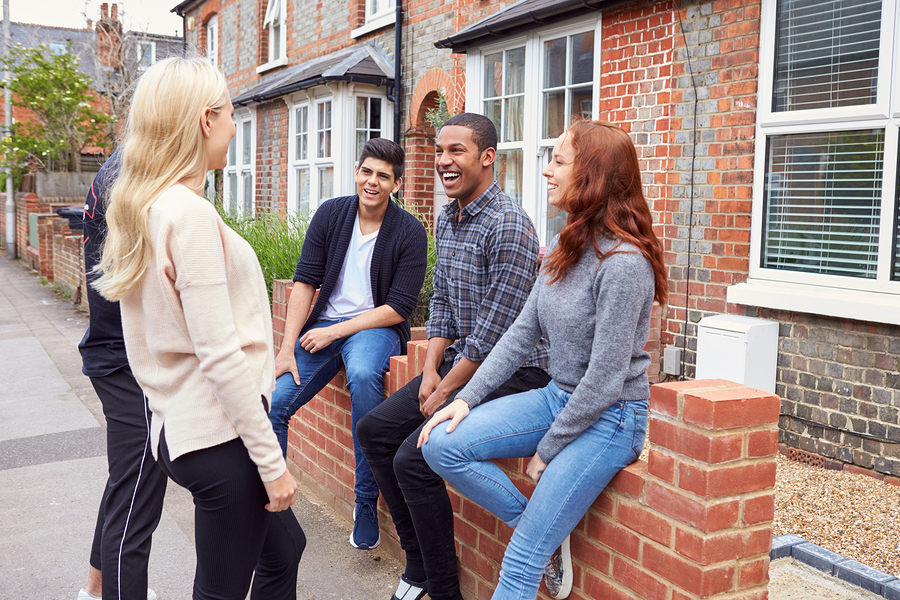Student housing is often the birthplace of real estate trends inspired by the youngest generations. For many students, it’s their first time living on their own and a chance to figure out what they want from their living arrangements.
As universities welcome Gen Z, student housing is shifting to meet the unique needs of its new tenants. These students (and their parents) know that college is an expensive endeavor, so their expectations are often narrowed down to essentials.
Here are some of the trends in student housing that are responding to those expectations by simplifying yet upgrading the college experience.
Choosing learning over luxury
Student housing is experiencing a back-to-basics trend. When it comes to amenities, incoming cohorts from the financially-savvy Gen Z are looking for housing options that offer the most value for the lowest price. They’re also serious about their education, so upscale features like enormous flat-screen TVs, gaming and arcade rooms, rockclimbing walls, and lazy rivers only serve as distractions. And since this generation of college students may be the largest yet, property owners may need to remove parking garages, pools, and other spacious amenities to make room for additional housing units.
Inside those units, bedrooms are becoming smaller, while common rooms have grown to promote collaboration and group activities. Comfortable study areas, multipurpose meeting rooms, and community kitchens coax students out of their rooms to get to know their peers. Because college isn’t just about classroom education — social learning opportunities ensure that students receive a well-rounded experience.
Creating diverse housing for diverse students
There’s no longer a one-size-fits-all approach to student housing. Whether divided up by floors or entire buildings, developers are starting to plan layouts based on the preferences and needs of the diverse groups of incoming students. These layouts may include flexible designs that are easy to modify as trends evolve and populations shift.
In addition, options are increasing for students who want to be close to everything. Mixed-use developments, which combine student housing with retail stores, businesses, restaurants, and even hotels for parent visits, are popping up to create centralized off-campus communities.
Promoting health and wellness
Poor physical and mental health can prevent students from getting the most out of their education. That’s why student housing projects are putting more emphasis on health and wellness amenities. Some of these efforts include:
- Vending machines that replace soda, potato chips, and candy with healthier options like salad bowls, enhanced water, fruit, and granola bars
- Fitness centers, spaces for group classes and sports, and meditation areas
- Large windows that let in more natural light and inviting outdoor environments that promote mental health
- Environments that encourage movement, such as attractive stairways that lure students away from the elevators or walkways that detour through gardens and green spaces
Changes like these help students stay active, balanced, and ready to learn.
Simplifying transportation
To avoid the costs of fuel and insurance, fewer students bring cars to college these days. Instead, they rely on ridesharing, public transportation, biking, or walking to get around. This has decreased the need for parking spaces and encouraged the addition of secure bike storage, bike-sharing programs, and designated curbside areas for ridesharing pickups and dropoffs.
Designing with sustainability in mind
As environmentally-conscious Gen Z moves into student housing, green building initiatives are taking center stage. Sustainable design features are “viewed very favorably” among students, particularly if housing properties have energy-efficient certifications such as a Leadership in Energy and Environmental Design (LEED) rating.
Here are some of the features benefiting the environment in student housing:
- Water conservation through low-flow plumbing and motion-activated fixtures
- Recycling and composting services
- Energy-efficient appliances, lighting, and heating and cooling systems
- Smart glass windows
- Solar panels
Though students don’t expect to pay extra for these upgrades, sustainable design often results in savings through reduced operating costs.
Enhancing connectivity and technology
From online courses and assignments to gaming and streaming services, students rely on high-speed internet to live and learn. And they don’t want to be tethered to their desks with cables and ethernet connections during work or play. To meet the expectations of increasingly mobile students, property managers must provide consistently fast internet with far-reaching WiFi — as well as plenty of outlets in common areas.
Developers are also making student housing facilities “smarter” with maintenance technologies like predictive analytics, automation, fault detection, and sensors. These make it easier for maintenance staff to foresee, diagnose, and respond to issues while minimizing student interruption.
Streamlining package delivery
With the nonstop rise of e-commerce, traditional campus mailrooms are overwhelmed with packages, and students are looking for faster, more convenient methods for picking up their orders. To secure those orders and allow 24/7 package retrieval, properties are increasingly installing package lockers. These don’t require staff assistance and automatically inform students about their deliveries.
—
Though technology has advanced student life, less is more in student housing these days. Minimizing excess and distractions, improving student health, and reducing environmental impacts are key components of new student housing developments. But they still allow residents to enjoy modern conveniences like ridesharing and package lockers.
Learn more about how smart package lockers contribute to a safer, simplified student living experience.



